Birch Barbara M. English L2 Reading: Getting to the Bottom
Подождите немного. Документ загружается.

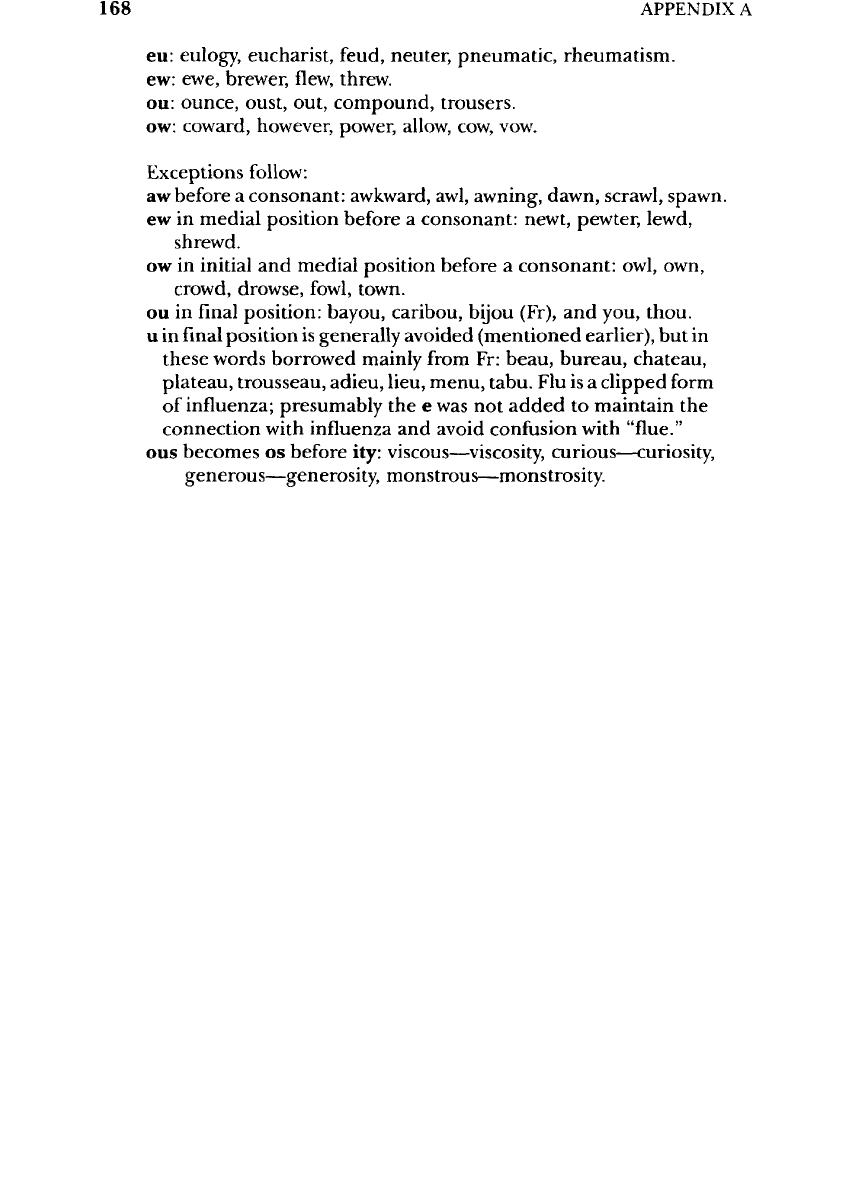
168
APPENDIX
A
eu:
eulogy, eucharist,
feud,
neuter, pneumatic, rheumatism.
ew:
ewe, brewer,
flew,
threw.
ou:
ounce, oust, out, compound, trousers.
ow:
coward, however, power,
allow,
cow, vow.
Exceptions
follow:
aw
before
a
consonant: awkward, awl, awning, dawn, scrawl, spawn.
ew
in
medial position before
a
consonant: newt, pewter, lewd,
shrewd.
ow
in
initial
and
medial position before
a
consonant: owl, own,
crowd,
drowse,
fowl,
town.
ou in final
position: bayou, caribou, bijou (Fr),
and
you, thou.
u
in
final
position
is
generally avoided (mentioned earlier),
but in
these words borrowed mainly from
Fr:
beau,
bureau, chateau,
plateau, trousseau, adieu, lieu, menu, tabu.
Flu is a
clipped
form
of
influenza; presumably
the e was not
added
to
maintain
the
connection
with
influenza
and
avoid confusion with "flue."
ous
becomes
os
before ity:
viscous—viscosity,
curious—curiosity,
generous—generosity,
monstrous—monstrosity.
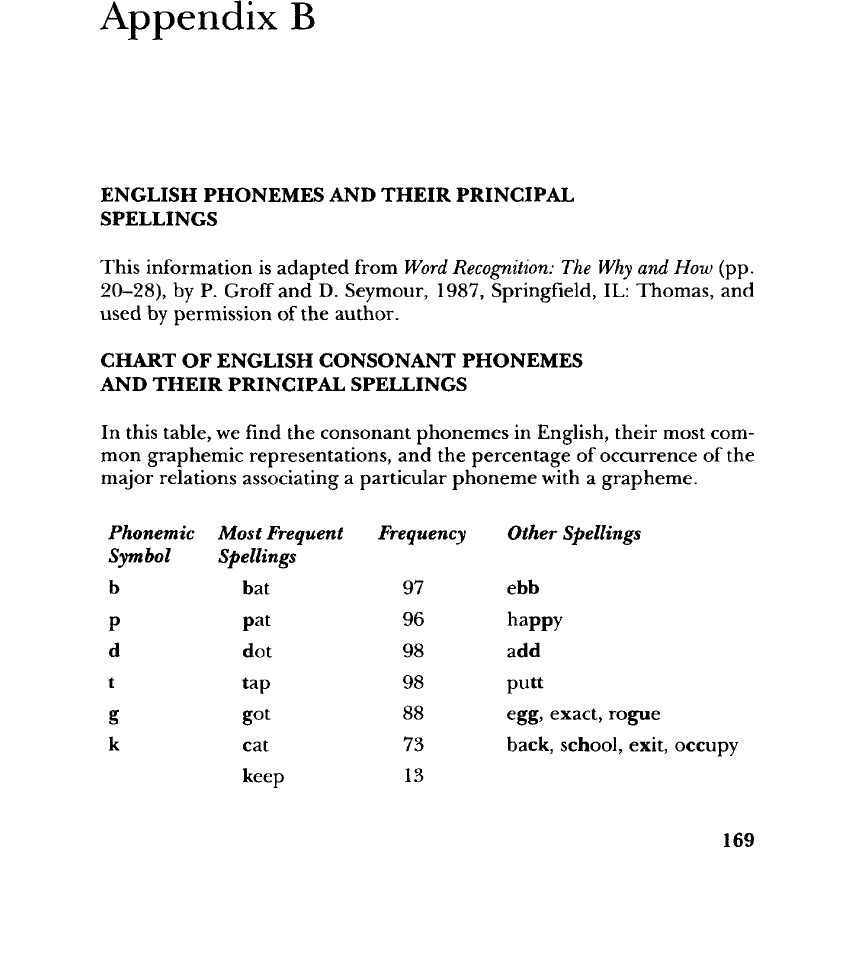
Appendix
B
ENGLISH
PHONEMES
AND
THEIR PRINCIPAL
SPELLINGS
This
information
is
adapted
from
Word
Recognition:
The
Why
and How
(pp.
20-28),
by P.
Groffand
D.
Seymour, 1987, Springfield,
IL:
Thomas,
and
used
by
permission
of the
author.
CHART
OF
ENGLISH CONSONANT PHONEMES
AND
THEIR PRINCIPAL SPELLINGS
In
this table,
we find the
consonant phonemes
in
English, their most com-
mon
graphemic representations,
and the
percentage
of
occurrence
of the
major
relations associating
a
particular phoneme
with
a
grapheme.
Phonemic
Most
Frequent
Frequency
Other
Spellings
Symbol
Spellings
b bat 97 ebb
p pat 96
happy
d dot 98 add
t tap 98
putt
g
got 88
egg, exact,
rogue
k
cat 73
back, school, exit, occupy
keep
13
169

170
APPENDIX
B
Phonemic
Symbol
tj
d3
V
f
d
e
z
s
3
J
h
m
n
0
1
r
y
w
Most
Frequent
Spellings
chap
culture
gem
jet
vat
fat
the
thin
as
zap
sat
cent
fusion
action
shut
hit
man
not
sing
bank
lap
run
senior
yet
wet
Frequei
55
31
66
22
99.5
78
100
100
64
23
73
17
82
53
26
98
94
97
59
41
91
97
55
44
92
Other
Spellings
watch
budget, educate
phone,
off
buzz,
dessert
pass,
scent
regime
social,
mission, pension,
ocean, chef
who
mummy
inn
all, able
pun-
liquid
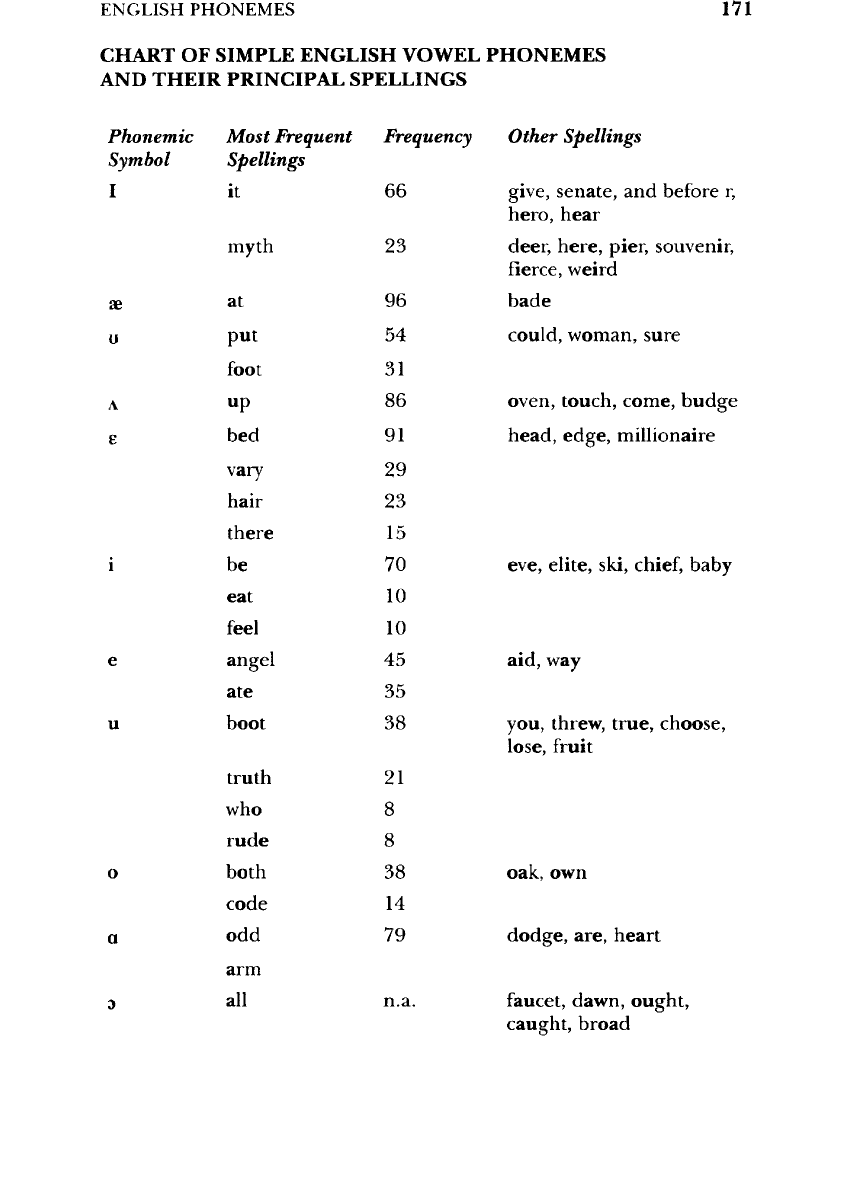
ENGLISH
PHONEMES
171
CHART
OF
SIMPLE ENGLISH VOWEL PHONEMES
AND
THEIR PRINCIPAL SPELLINGS
Phonemic
Most
Frequent
Frequency
Symbol
Spellings
I
it 66
myth
23
ae
u
A
e
i
e
u
o
a
3
at
put
foot
up
bed
vary
hair
there
be
eat
feel
angel
ate
boot
truth
who
rude
both
code
odd
arm
all
96
54
31
86
91
29
23
15
70
10
10
45
35
38
21
8
8
38
14
79
n.a
Other
Spellings
give,
senate,
and
before
r,
hero, hear
deer,
here,
pier, souvenir,
fierce,
weird
bade
could, woman, sure
oven,
touch, come, budge
head,
edge,
millionaire
eve, elite, ski, chief, baby
aid,
way
you,
threw, true, choose,
lose,
fruit
oak,
own
dodge,
are,
heart
faucet,
dawn, ought,
caught, broad
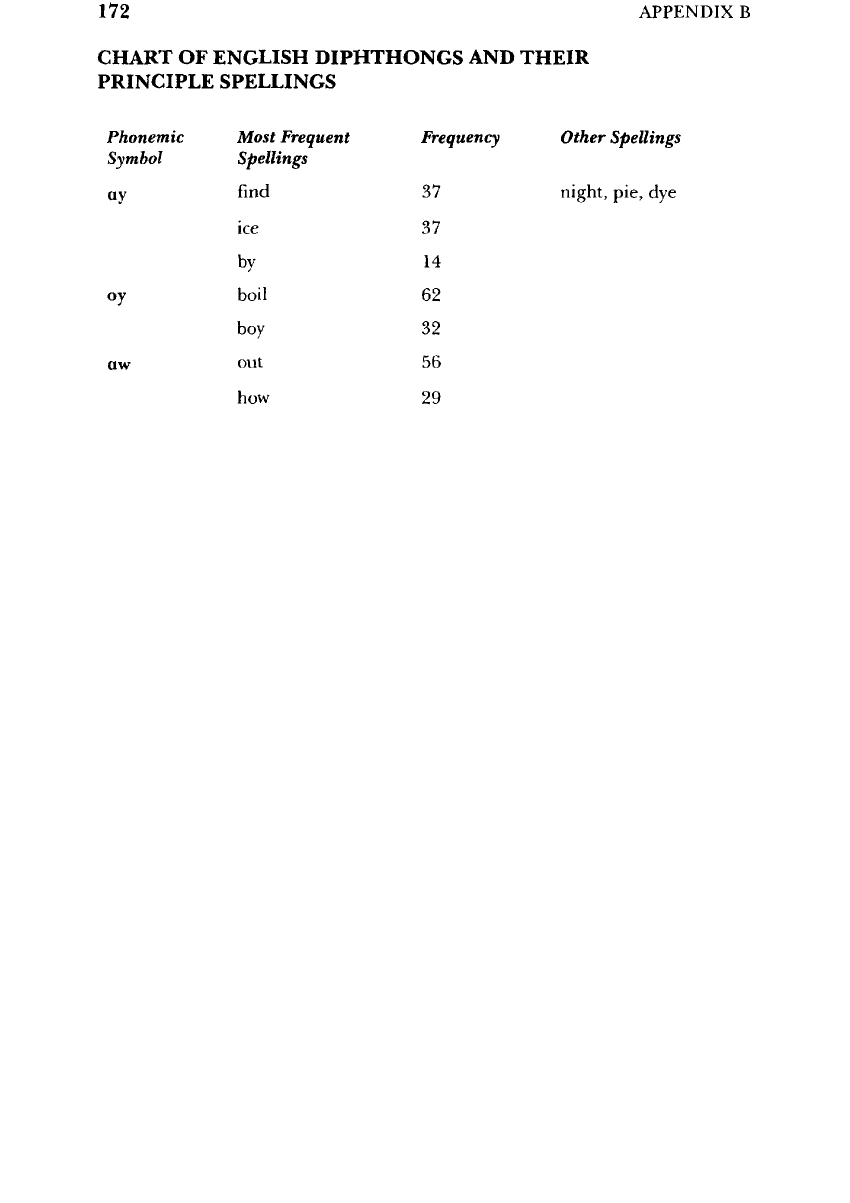
172
APPENDIX
B
CHART
OF
ENGLISH
DIPHTHONGS
AND
THEIR
PRINCIPLE SPELLINGS
Phonemic
Symbol
ay
oy
aw
Most Frequent
Spellings
find
ice
by
boil
boy
out
how
Frequency
37
37
14
62
32
56
29
Other Spellings
night,
pie,
dye
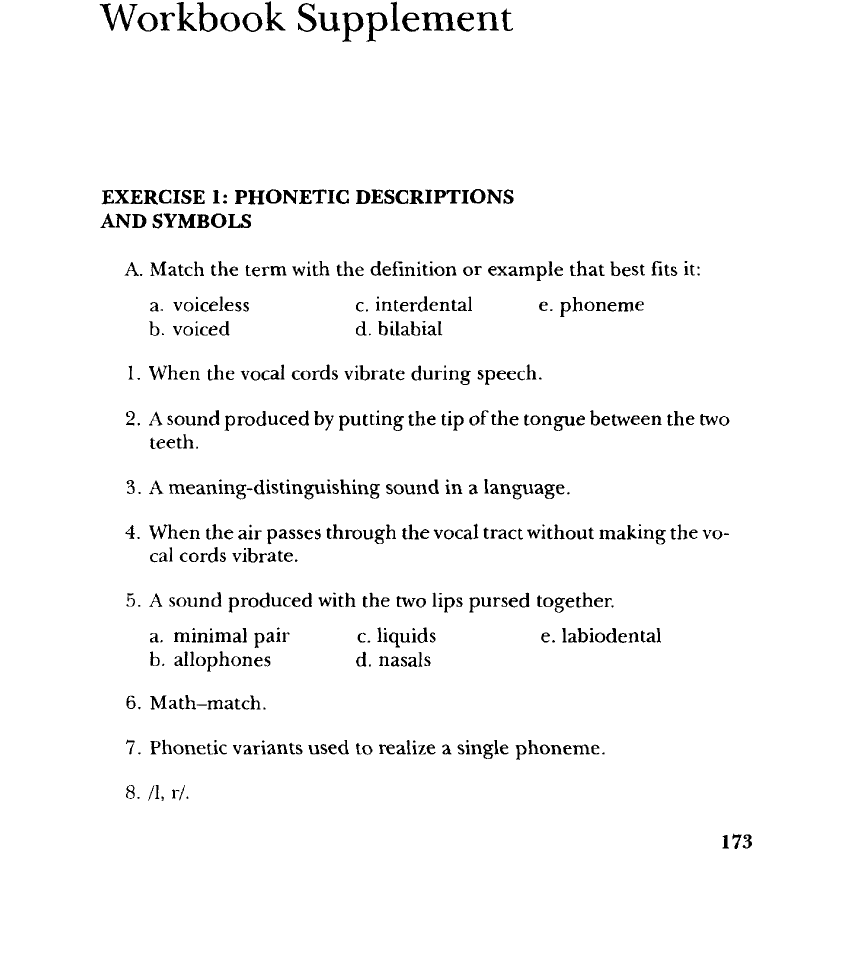
Workbook
Supplement
EXERCISE
1:
PHONETIC DESCRIPTIONS
AND
SYMBOLS
A.
Match
the
term with
the
definition
or
example
that
best
fits it:
a.
voiceless
c.
interdental
e.
phoneme
b.
voiced
d.
bilabial
1.
When
the
vocal cords vibrate during speech.
2.
A
sound produced
by
putting
the tip of the
tongue between
the two
teeth.
3.
A
meaning-distinguishing
sound
in a
language.
4.
When
the air
passes through
the
vocal tract without making
the vo-
cal
cords vibrate.
5.
A
sound produced
with
the two
lips pursed together.
a.
minimal pair
c.
liquids
e.
labiodental
b.
allophones
d.
nasals
6.
Math-match.
7.
Phonetic variants
used
to
realize
a
single
phoneme.
8.
/I,
r/.
173

174
WORKBOOK
SUPPLEMENT
9. A
sound produced
with
the
lower
lip
pressed against
the
upper
teeth.
10.
A
sound produced when some
of the air
escapes through
the
nose.
a.
alveolar
c.
fricative
e.
glide
b.
phone
d.
affricate
11.
When
the air
flow
is
constricted
by two
articulators, causing
friction.
12. /f, s, v, z/ are
examples
of
this type
of
sound.
13.
/y, w/ are
examples
of
this type
of
sound.
14.
/t,
d/,
s/
are
examples
of
this type
of
sound.
15.
A
sound produced when
the air
flow
is
stopped
and
then released
with
a
puff
of
friction.
B.
Write
the
phonetic symbol
and the
full
description
for the
final
sounds
in
these
words:
16.
wax 18.
pressed
20.
dear
22.
allow
17.
swish
19.
edge
21.
candy
23.
laugh
C.
Write
the
following
words
in
phonetic transcription
to
indicate
the
way
you say
them. Compare your answers
to
other
students'
an-
swers.
Are
there
any
differences
in the
transcriptions?
24.
penny
27.
orange
30. fish 33.
Think
25.
petty
28. cot
31.
jungle
34.
pleasure
26.
wash
29.
caught
32.
raisin
35.
other
EXERCISE
2:
SIMPLE VOWELS
A.
Get a
lollipop
and put it in
your mouth.
Go
over
the
chart
of
Eng-
lish
vowels
and say
each
cue
word. Notice
how the
lollipop moves
as
your
tongue moves.
B.
Say the
following
sets
of
words.
Are the
vowels
the
same
or
different
the
way
you say
them? Select
the
phonetic symbol
from
the
previous
chart that
represents
the
sound
of the
vowels
as you say
them.

WORKBOOK
SUPPLEMENT
175
WORDS
SAME/DIFFERENT PHONETIC SYMBOLS
No. 1 No. 2
tan
ton
different
&
tin
ten
teen
tune
Dane tone
dune done
Tom
tome
Don
Dawn
cut
cat
cot
caught
coot
coat
cane
can
C.
Compare your answers
with
your classmates.
Do
you
find
any
varia-
tion
in the
pronunciation
of
some words?
EXERCISE
3:
PHONOLOGICAL PROCESSES
IN
ENGLISH (PART
1)
A.
There
are
three true diphthongs that occur
in
English: /oy/,
/aw/,
and
/ay/.
Identify
the
diphthongs
in the
following words: house,
fight,
kite,
white, poison, toy, flounce,
and
about.
B.
The
glides
/y/
and
/w/
usually
occur
with some
of the
simple vowel
phonemes
in
English (the tense
vowels)
when they
are
pronounced.
a.
Transcribe
the
vowels
in the
following
words using
a
diphthong
(tense
vowel
plus
[y] or
[w]):
bead, bade, leap, lay,
booed,
bode,
school, poll. Write these vowels
in the
middle
of [ ],
because they
are
"phones"
and not
"phonemes." Which
vowels
take
[y] and
which
take
[w]?
b.
Spanish does
not
have these diphthongized vowels. Speakers
of
English
who
learn Spanish
often
have trouble "removing"
the
diphthongs
from
their speech,
so
they
can get rid of
their accent.
Say
these words
in
Spanish.
If
there
is a
Spanish speaker
in the
class, compare
the way you say the
following words:
amigo,
taco,
No
fumar,
and
Que.
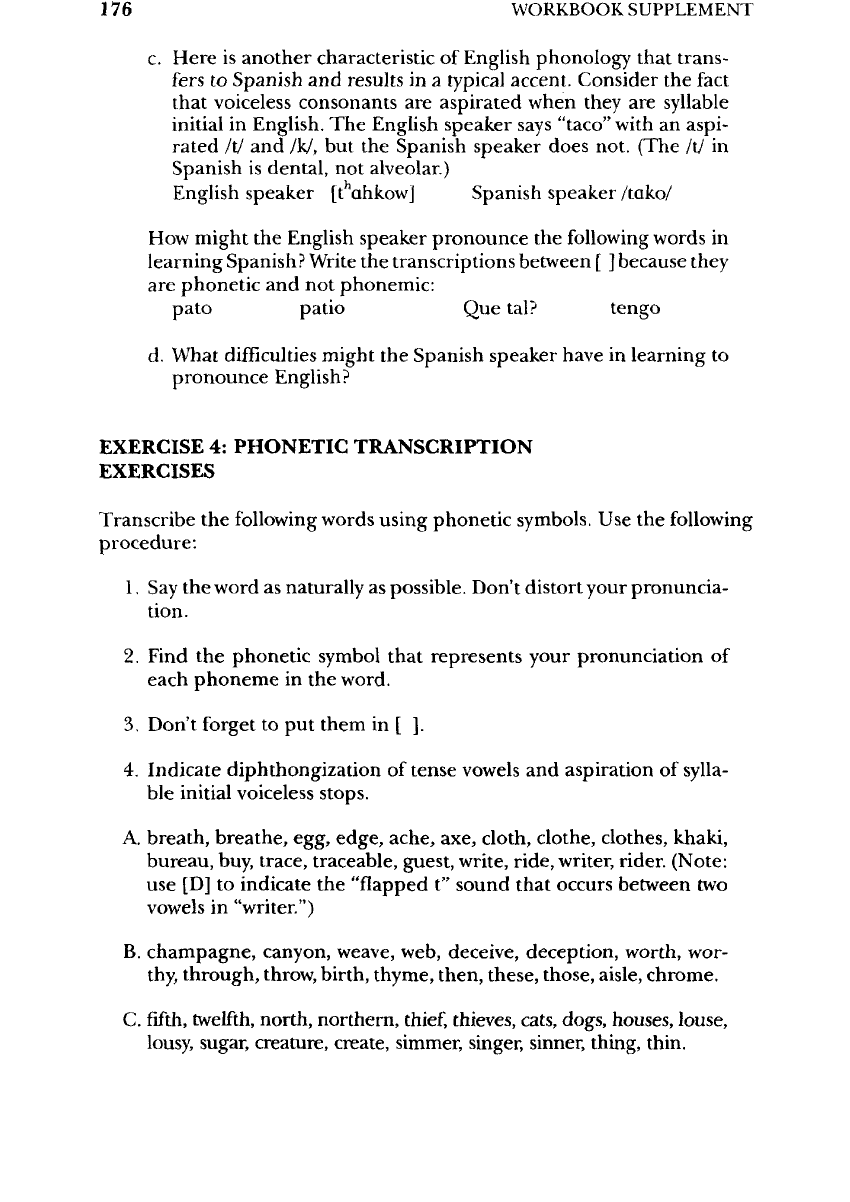
176
WORKBOOK
SUPPLEMENT
c.
Here
is
another characteristic
of
English phonology that trans-
fers
to
Spanish
and
results
in a
typical
accent. Consider
the
fact
that voiceless consonants
are
aspirated when they
are
syllable
initial
in
English.
The
English speaker
says
"taco"
with
an
aspi-
rated
/t/
and
/k/,
but the
Spanish speaker does not. (The
/t/
in
Spanish
is
dental,
not
alveolar.)
English
speaker
[t
h
ahkow]
Spanish speaker /tako/
How
might
the
English speaker pronounce
the
following
words
in
learning Spanish? Write
the
transcriptions between
[ ]
because they
are
phonetic
and not
phonemic:
pato patio
Que
tal?
tengo
d.
What
difficulties
might
the
Spanish speaker have
in
learning
to
pronounce English?
EXERCISE
4:
PHONETIC TRANSCRIPTION
EXERCISES
Transcribe
the
following words using phonetic symbols.
Use the
following
procedure:
1.
Say the
word
as
naturally
as
possible.
Don't
distort your pronuncia-
tion.
2.
Find
the
phonetic symbol that represents your pronunciation
of
each
phoneme
in the
word.
3.
Don't forget
to put
them
in [ ].
4.
Indicate
diphthongization
of
tense vowels
and
aspiration
of
sylla-
ble
initial voiceless stops.
A.
breath,
breathe,
egg,
edge,
ache, axe, cloth, clothe, clothes, khaki,
bureau, buy, trace, traceable, guest, write, ride, writer, rider. (Note:
use
[D] to
indicate
the
"flapped
t"
sound that occurs between
two
vowels
in
"writer.")
B.
champagne, canyon, weave, web, deceive, deception, worth, wor-
thy,
through,
throw, birth, thyme, then, these, those, aisle, chrome.
C.
fifth,
twelfth,
north, northern,
thief,
thieves, cats, dogs, houses, louse,
lousy,
sugar, creature, create, simmer, singer, sinner, thing, thin.
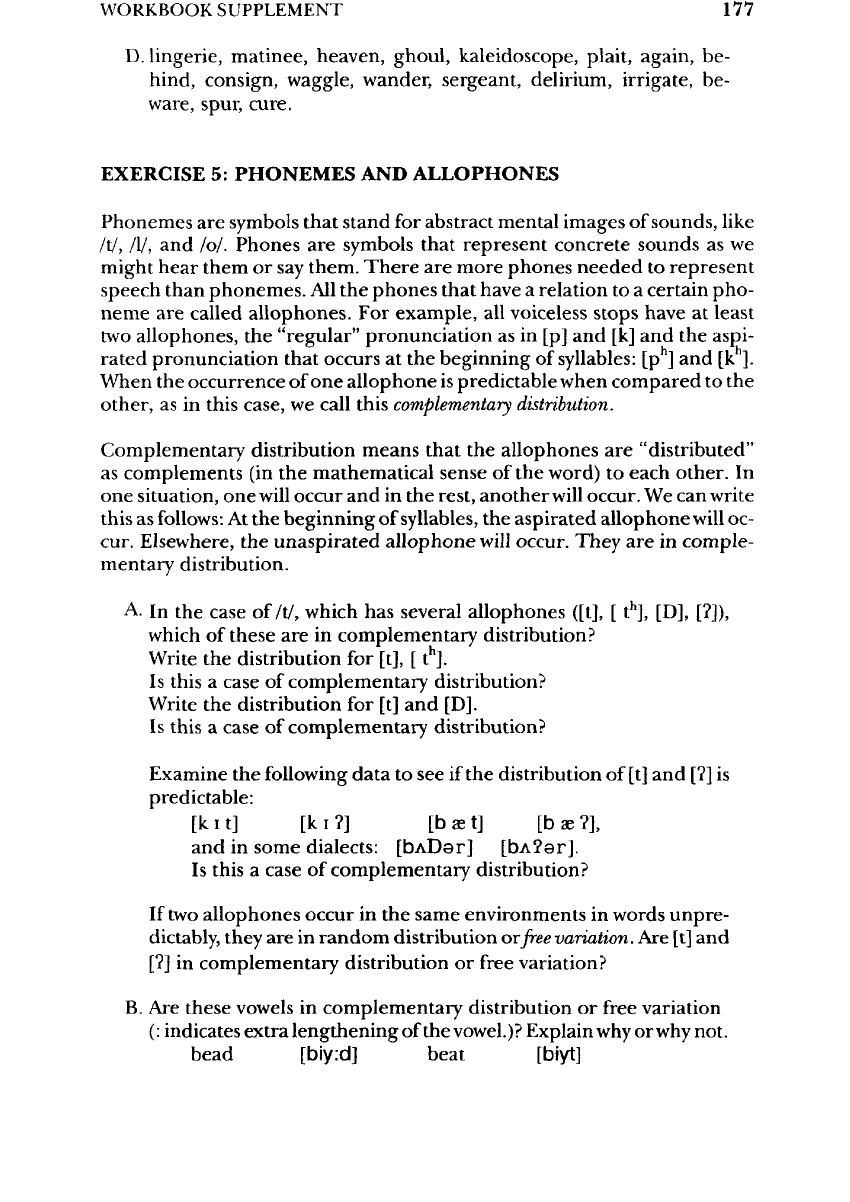
WORKBOOK
SUPPLEMENT
177
D.
lingerie, matinee, heaven, ghoul, kaleidoscope, plait, again,
be-
hind,
consign, waggle, wander, sergeant, delirium, irrigate,
be-
ware,
spur, cure.
EXERCISE
5:
PHONEMES
AND
ALLOPHONES
Phonemes
are
symbols that stand
for
abstract mental images
of
sounds, like
/t/,
/!/,
and
/of.
Phones
are
symbols that represent concrete sounds
as we
might
hear them
or say
them.
There
are
more phones needed
to
represent
speech than phonemes.
All the
phones that have
a
relation
to a
certain pho-
neme
are
called allophones.
For
example,
all
voiceless stops have
at
least
two
allophones,
the
"regular"
pronunciation
as in [p] and [k] and the
aspi-
rated pronunciation that occurs
at the
beginning
of
syllables:
[p
h
]
and
[k
h
].
When
the
occurrence
of one
allophone
is
predictable when compared
to the
other,
as in
this case,
we
call this
complementary
distribution.
Complementary distribution means that
the
allophones
are
"distributed"
as
complements
(in the
mathematical sense
of the
word)
to
each other.
In
one
situation,
one
will
occur
and in the
rest, another
will
occur.
We can
write
this
as
follows:
At the
beginning
of
syllables,
the
aspirated allophone
will
oc-
cur. Elsewhere,
the
unaspirated
allophone
will
occur.
They
are in
comple-
mentary
distribution.
A.
In the
case
of
/t/,
which
has
several allophones ([t],
[
t
h
],
[D], [?]),
which
of
these
are in
complementary distribution?
Write
the
distribution
for
[t],
[
t
h
].
Is
this
a
case
of
complementary distribution?
Write
the
distribution
for [t] and
[D].
Is
this
a
case
of
complementary distribution?
Examine
the
following data
to see if the
distribution
of [t] and [?] is
predictable:
[kit]
[ki?]
[baet]
[b
se
?],
and in
some dialects:
[bADar]
[bA?ar].
Is
this
a
case
of
complementary distribution?
If
two
allophones occur
in the
same environments
in
words unpre-
dictably,
they
are in
random distribution
or
free
variation.
Are [t] and
[?]
in
complementary distribution
or
free
variation?
B.
Are
these vowels
in
complementary distribution
or
free variation
(:
indicates extra lengthening
of the
vowel.)?
Explain
why
or
why
not.
bead
[biyrd]
beat
[biyt]
